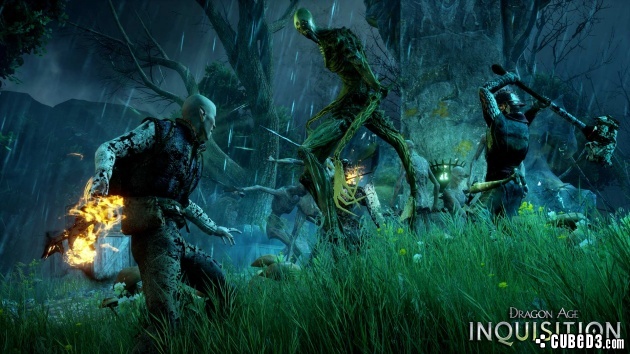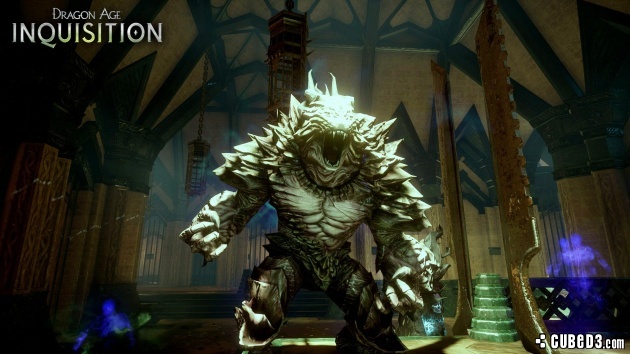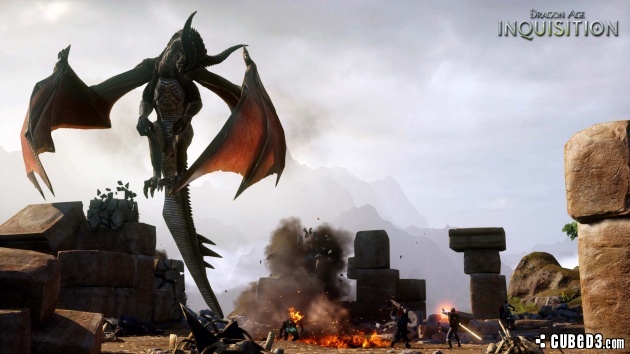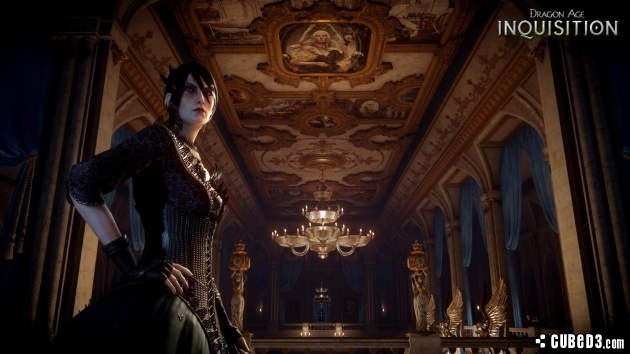Dragon Age: Inquisition (PlayStation 4) Review
By Drew Hurley  30.11.2014
30.11.2014

The first Dragon Age was critically acclaimed, and rightly so. It set up a rich and fantastic world with highly likeable characters, combining a truly epic story and a great combat system. The second jumped across the world and changed everything, from the style of the combat to the cast. It was not well received. It had big flaws in the gameplay and lazy work, like reusing the same dungeons over and over. Bioware has addressed these flaws, returning with a true successor to the original.
Dragon Age: Inquisition picks up after Dragon Age 2. The Mage/Templar war has continued since the events of Kirkwall and the story begins with a peace talk between the two groups called The Conclave. Before the talks can even begin, the meeting is destroyed in a catastrophic explosion, killing the attendees and leaving a giant green "Rift" in the sky that demons come pouring through. Smaller versions of the Rift also seem to start to appear, scattered across the world, each acting as gateways for the demons.
The protagonist is the only survivor of The Conclave and remembers little of what happened, just being in the explosion and then suddenly being trapped in the dimension the demons come from, "The Fade." They manage to escape thanks to the help of an iridescent woman, and all the while demons are hot on their heels. Awakening after the event, the lead character joins with "The Inquisition," made up of Dragon Age alumni, being led by Casandra from Dragon Age 2 and Leliana from Dragon Age Origins, along with a host of other familiar faces, good and bad.
At its heart it's the classic RPG story of gathering allies to combat a big bad, but what makes this game the diamond that it is has to be the spectacular storytelling. The relationships between characters and the interactions they have make it a joy to play and this crafts a world that drags attention back constantly.

Story is the highlight of the game; a vast and epic tale that is in no way predictable and manages to up the stakes over and over. As it develops its well made methods of branching out come to light, allowing the player to follow their own path at their own pace. Want to investigate Templars or Mages? Or even Grey Wardens? Each choice opens up more of the story, more history and more characters for the Inquisition.
Despite all this rich history, though, the game is still accessible to those who are new to the franchise. The back-story is fully explained and there is an encyclopaedia's worth of information on the world available throughout. This becomes one of the biggest strengths. Finding out so much about the world, the people that live there, and, especially, the cast of inquisition gives a real sense of investment in the world. The very best stories are based on this premise; if the players really care about the characters, if they can become invested in their struggles and the relationships between them, the story is truly a success and it will keep gamers coming back.
Dragon Age: Inquisition offers four difficulty settings: casual, normal, hard and nightmare. Fans of classic RPGs will find great worth in pairing the nightmare difficulty with the tactical camera way of playing. Although it isn't always necessary, on certain boss encounters it can make for great experiences, having to set up each character's strengths and abilities - along with pausing or slowly progressing time, this makes for a classic RPG combat system in a modern new way.

Some of the classic tropes of RPGs return, like the holy trinity of healer, tank and damage dealer, but in a strange way completely it does away with traditional healing. Instead, the Mages use barriers as extra health bars, there are no standard healing spells - if barriers are down and characters are getting hit, then potions are the only alternative. This takes a little getting used to and also means the gathering and crafting becomes a large necessary aspect on higher difficulties to maintain potion supplies.
Also with the tropes are the roles: the big three of Mage, Warrior and Rogue that can then become specialised later in the game with the use of talent trees - Archers against Daggers, Sword and Shield against two-handed weapons, elemental choices for a mage. Much later in, there are further specialisations with unique skills to unlock. It's really worth taking one of each type in the party, however, as there are unique environment restrictions that can only be undone by each role. Warriors can kick down walls, mages can craft bridges or paths, and rogues can as always pick locks.
The world is ridiculously big; indeed the first open area the player can explore, "The Hinterlands," has tens of hours of playtime alone, and there are many, many areas of this size throughout the game. This can cause a bit of a stumbling block for completionists - there are an awful lot of MMO and classic RPG-style quests here. Fetch quests and kill quests and collectibles that many completionists will get the urge to try and get that all-important 100% before moving on, but it's really the wrong way to go about it. The Hinterlands is returned to numerous times through the adventure, with extra things opening up as time progresses, and the game is so rich it's worth unlocking more characters and abilities to use while working through the side-quests. Nothing in these open world areas is likely to be missed and all areas and collectibles can be returned to even after finishing the main story.
Dragon Age: Inquisition controls access to these giant areas using a "War Room." Here the Inquisition plans operations; it can be used to send the party around the world but primarily is used for sending the Inquisition leadership of Leliana, Josephine, and Cullen on missions. These take place in real-time so can be progressed through while playing or even while away from the game. The NPCs will head off, gathering resources or performing acts of diplomacy for the Inquisition that can take anywhere from 10 minutes to 24 hours. This map is also used to unlock new areas, either for side-quests or as part of the story. The way the game gates content is by requiring "Power" to open up both side-quests and story quests, which can be gathered by completing areas, completing requisition requests, or completing objectives. It's easy to rack up and doesn't gate content excessively.

Every time completion looks to be at hand, little extras get added. On top of everything else, there are gathering systems and a wealth of crafting to make use of the mats attained - creating and modifying weapons, armour, potions, and eventually even customising the home of the Inquisition. Later on there is even a system setup where the protagonist has to sit in on the judgement of criminals and captured enemies. From the serious to the surreal, these choices bring comedy and hard grey areas that Bioware is famous for: is a soldier who was just following orders really to blame, and what IS to be done when someone attacks that castle by throwing goats at it?
Fans of the series have a lot of Easter eggs to look forward to; the game has a wealth of information on what happened to the characters of the first two releases, along with showing how the wider picture has changed - how the civilizations of the world have grown and developed. Lore fans will find they can find out everything that has happened in the decade since the first game, although Bioware is wise enough to drag out some reveals. They hit like an emotional sledgehammer at points, yet the game manages to balance the emotional parts with comedy. The selection of party members and romance choices are fully developed characters and none feel like clichés or two-dimensional. It's impressive to see even smaller characters being well developed.
The cast really does stand out and talking with them is a real highpoint. It's worth switching up the party through the game and developing relationships with each. They all have big stories to tell and it's hard not to like them. A particular stand out is Iron Bull - it is well worth having him and Dorian in a party at the same time for their interactions alone.
Players will want to keep coming back to find out a little bit more, to search for one more secret, to get one more anecdote from Iron Bull, to hear more party interactions. There's so much here and it's all so very good. There is perhaps only Skyrim that has previously tried something so ambitious and done it so well and with so few flaws.

Cubed3 Rating
Exceptional - Gold Award

There's little more that can be said; Bioware seems to have taken every negative thing said about Dragon Age 2 on board and improved upon each and every one of them. This is a real love letter to its fans and one of the best games to hit in a long time. Now about that next Mass Effect game… and the ending of number three...
Comments
Comments are currently disabled

 Sign In
Sign In Game Details
Game Details
 Out now
Out now  Out now
Out now  Out now
Out now  Out now
Out now  Subscribe to this topic
Subscribe to this topic Features
Features





 Top
Top

